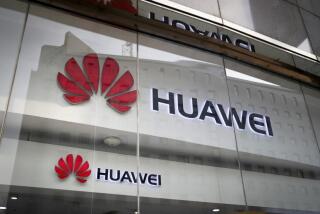Sony to Invest $1.67 Billion in Semiconductor
- Share via
Riding the immense popularity of its PlayStation video game consoles, Sony Corp. said Monday that it would spend $1.67 billion to make a new semiconductor designed to handle not only games but also music and movies.
The so-called Cell chip is the heart of Sony’s strategy for serving up digital entertainment via an array of devices connected to one another and to the Internet, with the next-generation PlayStation 3 console functioning as the hub.
“Sony is providing a glimpse of the future connected home,” said Mike Feibus, principal analyst at TechKnowledge Strategies Inc. in Scottsdale, Ariz. “And it looks as if Sony sees the PS3 as the core of that.”
With PlayStation 2 in 50 million homes worldwide and about 16% of U.S. homes, the console is one of the most widely embraced gadgets. Sony, the world’s second-largest consumer electronics maker, is seeking to use PS2’s popularity to win acceptance of PS3 as an all-purpose home entertainment platform.
“The combination of computer entertainment and digital consumer electronics products will be a very important driving force for Sony’s future,” Sony Computer Entertainment President Ken Kutaragi told reporters in Tokyo.
Sony has said little about its intentions for the Cell chip since it announced an agreement two years ago to jointly design the microprocessor with IBM Corp. and Toshiba Corp.
The three companies invested a combined $400 million and assigned 300 engineers to design a blueprint of the chip in IBM’s Austin, Texas, offices. Each company retains the rights to make products that use the chip.
Designed to be 1,000 times more powerful than those in the PS2, the chip is meant to be adept at handling massive video, graphics and audio files. Using a “stacked architecture,” manufacturers can combine up to eight chips to drive powerful servers to create digital media or use a single chip in hand-held organizers and cell phones.
It is expected to be in mass production by 2005 for various consumer electronics devices, including the PS3.
Sony’s $1.67 billion will be devoted to developing manufacturing capabilities and is separate from the joint effort on the chip’s blueprint. The sum is “lower than one would expect,” given the $2-billion average price tag for a cutting-edge chip plant, said Peter Glaskowsky, editor of the Microprocessor Report in San Jose.
Still, it is “a huge economic commitment at a very tough time,” said Richard Doherty, research director at technology consulting firm Envisioneering Group in Seaford, N.Y.
The chip will be manufactured at a Sony computer plant in Japan’s Nagasaki region.
The next evolution in home entertainment is a box capable of managing a full array of music and video and of piping it around the house, said Larry Gerbrandt, chief content officer for Kagan World Media, an entertainment consulting firm owned by Primedia Inc.
Although many approaches are being tried, he said, building that box around a game console “makes a lot of sense” because consoles have established their place attached to a TV.
Analyst Tim Bajarin of Creative Strategies in Campbell, Calif., said several companies were developing boxes that can connect to a television and control all forms of entertainment.
But rather than marketing a do-everything version of the PlayStation, Bajarin said Sony would be better off with a flexible basic unit with optional add-ons.
There won’t be much of a market for media centers, however, until high-speed Internet connections become common and much more entertainment is delivered online, Bajarin said. He predicted demand wouldn’t kick in for at least three years.
Gary Arlen, an independent consumer electronics analyst, said a potential problem for Sony was how to position a souped-up PlayStation in its lineup of home entertainment products.
“They’ll be competing with themselves if they take [the PlayStation] too far,” he said.
*
Bloomberg News was used in compiling this report.





